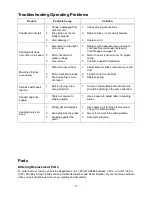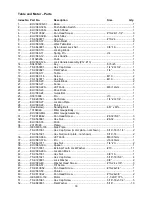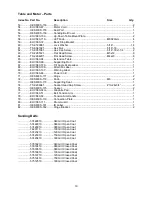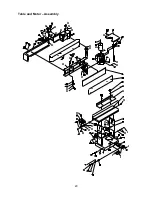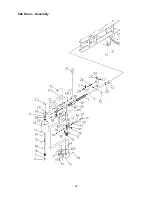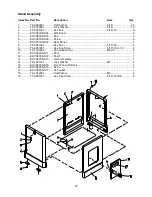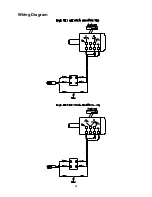
15
Basic Operations
Removing the belt guard
exposes more of the sanding belt! Replace the
belt guards immediately after completing any
sanding that requires its removal! Failure to
comply may cause serious injury!
Horizontal Sanding
For
horizontal sanding
, the
platen
is locked in the
horizontal position as shown (F) and the
removable
fence
(D) is secured to the
table
(E) as follows.
Referring to Figure 16:
1. Place
5/16
flat washers
(not shown) and
guide
blocks
(B) on two 12mm
lock knobs
(A) – Note:
the 12mm refers to the threaded shaft length.
2. Insert the
guide blocks
(B) into the
miter slot
(C) and position the
lock knobs
(G) on the
table
(E) as shown.
3. Place the
removable fence
(D) on the table
and secure by tightening the
lock knobs
(G, Fig. 16 and Figure 17).
The
backstop
(H, Fig. 17) can also be used by
swiveling the
drum guard & dust port
(J, Fig. 17)
out of the way and placing the backstop pin in the
positioning hole and securing in place with the
lock
knob
(K, Fig. 17) and 5/16"
flat washer
.
Note:
This
is better shown in Figure 18. The
drum guard &
dust port
(J, Fig. 17) can then be returned to the
position shown.
Vertical Sanding
Referring to Figure 18:
For
vertical sanding
, the
platen
(G) is locked in the
vertical position as shown and the
backstop
(H)
and/or the
miter gauge
(B) may be used.
Miter Gauge
1. Slide
the
guide bar
(D) of the
miter gauge
(A)
into the
miter slot
(C) on the table.
2.
Set the miter angle; then secure the miter by
tightening the
lock handle
(B).
Backstop
Place the backstop pin in the positioning hole and
secure in place with the
lock knob
(E) and 5/16"
flat washer
(F).
Figure 16
Figure 17
Figure 18
Summary of Contents for OES-80CS
Page 20: ...20 Table and Motor Assembly...
Page 22: ...22 Idle Drum Assembly...
Page 24: ...24 Wiring Diagram...

















